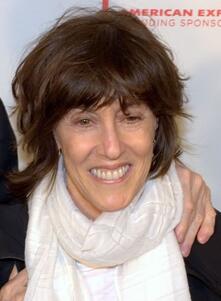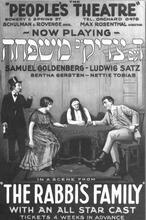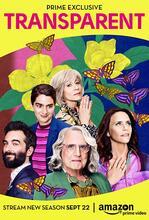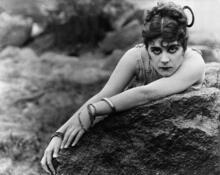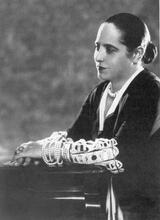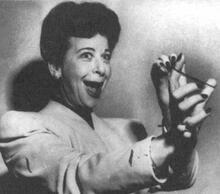Film Industry in the United States
Actress, singer, film director/producer, and founder of the Streisand Foundation, Barbra Streisand in 1962.
Photo from Wikimedia Commons.
Women have made vital contributions to the United States film industry throughout its history, both behind and on the screen. In this male-dominated business, women have had to fight for their place, of course, from the earliest days of silent film to the present moment. More specifically, while Jewish men have had an outsized role in the establishment, development, and triumph of film, Jewish women have struggled to be recognized and valued for their efforts. Despite the lack of equal opportunity, however, Jewish women have played crucial roles in the industry. Their work – despite sexism and sometimes antisemitism – deserves to be explored, understood within its historical and cultural contexts, and celebrated.
Early Cinema Through the Golden Age (1920s-1950s)
The early twentieth century provided multiple roles for women in film. Although largely unknown today (despite efforts by feminist scholars and documentary filmmakers), some of cinema’s earliest and greatest pioneers included women directors, producers, screenwriters, and actresses, from Alice Guy-Blaché and Lois Weber to Frances Marion and Mary Pickford. Jewish women’s most important contributions were as writers. A number of influential films with Jewish themes, in particular, were either written by Jewish women for the screen or adapted from novels and stories they wrote.
Anzia Yezierska, for instance, wrote fiction with a focus on the struggles of Jewish immigrant women. Two of her works, based on personal experience in the New York ghetto, were adapted for the screen: the short story collection Hungry Hearts (1922) and the novel Salome of the Tenements (1925). Both films attest to the harsh circumstances of immigrant Jewish existence, particularly for women. Yezierska’s own involvement in the film industry was bittersweet. She experienced a clash between her working-class, immigrant roots and the upper-class pretentions of the wealthy in Hollywood, causing her to leave after five years. Sadly, when she returned to New York, she found herself equally lonely – too “educated” for New York Jewish ghetto life and too earthy for Hollywood.
Another writer whose fiction contributed significantly to silent and later sound films was Fannie Hurst. Hurst was often dismissed as a sentimentalist, her writing popular rather than literary. Films based on Hurst’s work fall generally within the genre of melodrama – a.k.a. “the weepies” or “the woman’s film.” This type of film was largely derided until the second wave of the women’s movement brought feminist critics to reevaluate it. Today we know it was important for its central focus on the emotional lives of women. Unlike Yezierska’s work, Hurst did not focus on Jewish women’s lives. Perhaps the most enduring film inspired by her work is Imitation of Life (1934, remade in 1959), which entails a supportive (though in places quite patronizing) relationship between two struggling single mothers, one white and one black.
Adaptations of Hurst’s work were not the only films to deemphasize Jewishness in the U.S. film industry by the 1930s. Although Yiddish film briefly flourished in the mid-1930s, films of Hollywood’s Golden Era (1930s-1950s) generally avoided ethnic specificity and religious content. Immigrant Jews sought to belong to America, to assimilate as fully as possible. To many in Hollywood, this effort meant resisting efforts to portray their personal and group experiences. This was especially true during World War II, when the Jews who dominated Hollywood (the “moguls”) did not want to plead special cause and thereby risk provoking anti-Semitism. They felt they must show they were Americans first and Jews second. This did not stop Jewish women from continuing to contribute actively, however. Tess Slesinger, for example, unlike Yezierska and Hurst, found success working directly within the industry, penning many successful screenplays, including scripts for The Bride Wore Red (1937), The Good Earth (1937), and A Tree Grows in Brooklyn (1946). She also acted as screenwriter for Dance, Girl, Dance (1940), directed by Dorothy Arzner, Hollywood’s only female (and lesbian) studio director. One wonders what more the talented Slesinger might have accomplished had she not died of cancer at 39.
Other Jewish American film-writing notables include Francis Goodrich, who adapted material with her husband, Albert Hackett, including the Thin Man series, It’s a Wonderful Life (1946), Father of the Bride (1950), and Marjorie Morningstar (1958). The couple also wrote the screenplays for The Hitler Gang (1944) and The Diary of Anne Frank, both dealing with the atrocities of Nazi Germany and for that reason rarities in this period.
Another important husband-wife team was the prolific Phoebe Ephron and husband, Henry. Together, they wrote for such films as There’s No Business Like Show Business (1954), Carousel (1956), Desk Set (1957), and Captain Newman, M.D. (1964), which was nominated for an Academy Award. Fay Kanin, too, worked with her husband, Michael, on film and TV movies, such as Rhapsody (1954), Teacher’s Pet (1958), and Tell Me Where It Hurts (1974). She also served as president of the Academy of Motion Picture Arts and Sciences, the first woman to hold this position. Sylvia Fine and Danny Kaye were also a husband-and-wife writing duo. Unknown to many, Fine wrote most of the lyrics for Kaye’s screen performances.
Writing pairs did not only include married couples. Betty Comden was brought by MGM from Broadway to write for Hollywood in the late 1940s. Together with Adolph Green, she wrote the scenario and songs for multiple well-known Hollywood musicals, including Singin’ in the Rain (1952).
Perhaps the single most prolific Jewish woman screenwriter is little known today. Over the course of her career, Sonya Levien wrote more than seventy screenplays, ten with humorist S.N. Behrman, two with William Ludwig, and at least thirty-one on her own. She won an Academy Award for Interrupted Melody (1955).
Far more famous is Dorothy Parker, the Manhattan wit, who began her successful Hollywood career in the late 1930s. She wrote the original A Star Is Born (1937) with her husband, Alan Campbell. Later Parker worked with other writers on Saboteur (1942) and contributed dialogue to several films, including The Little Foxes (1941), based on the play by Lillian Hellman. Hellman herself not only wrote original, highly successful theatrical plays but also adapted most of them to the screen and penned some original screenplays.
Beyond the category of writing for the screen, Adeline Schulberg proved that it was possible, though not common, for Jewish women to take part in other traditionally male-dominated parts of Hollywood. Her Ad Schulberg Agency, operating in the 1930s, represented such stars as Marlene Dietrich, Frederic March, and Herbert Marshall. During World War II, Schulberg lived in London, where she set up an “underground railroad” for refugee talent from Nazi Germany. After the war, she worked as a talent scout for Columbia Pictures. She is also credited with giving Shelley Winters her start in film.
Maya Deren was the exception to all the rules limiting women’s behind-the-scenes roles in Hollywood film. Considered the mother of underground film, she operated completely outside the Hollywood system and was therefore not governed by any of its dictates. Deren was one of the earliest of the experimental avant-gardists. From 1943, when she made her first film, Meshes of the Afternoon, until her death in 1961, she influenced actors, artists, photographers (including Diane Arbus), and filmmakers.
New Hollywood (1960s-1970s)
America experienced huge social and political changes in the 1960s and 1970s, reflected in the period’s “new Hollywood.” Correspondingly, Jewish women’s roles in the film industry began to expand. The movements promoting racial and ethnic pride led to an increase in Jewish stories and characters. Marching through the doors opened by the women’s movement, Jewish women moved into previously male jobs such as producing and directing.
A major trailblazer of the era was writer, director, and comedian Elaine May. After starring in Enter Laughing (1967), she turned to writing and directing films at a time when few women had won this opportunity. She also directed material about Jewish characters. Her first picture was A New Leaf (1971), for which she served as writer, director, and star. She next directed The Heartbreak Kid (1972), based on a screenplay by Neil Simon, about a newly married Jewish couple. She directed only two films between 1972 and 2016, when she helmed an episode of American Masters on her longtime comedy partner, Mike Nichols. She may have faced frustration and limited success in directing for Hollywood, but her writing has been broadly appreciated, including two Oscar nominations as screenwriter, for Heaven Can Wait (1979) and Primary Colors (1998).
Joan Micklin Silver, who began in educational filmmaking, actively sought to bring Jewish women and Jewish subjects to the screen. In the early 1970s, she struggled to interest a Hollywood studio in a film about early Eastern European immigrants, which would even incorporate some Yiddish. No one was interested, so she wrote, directed, and produced (with her husband) Hester Street (1975), a film that took Abraham Cahan’s novella Yekl and shifted its focus from a Jewish immigrant man’s assimilation to that of his wife. Gitl (Carol Kane in her Oscar-nominated first leading role) offers a proto-feminist take on the compromises and promises of the American dream. More than a decade later, Silver would return to the life of a young Jewish woman with a more post-feminist slant in Crossing Delancey (1988), starring Jewish actress Amy Irving.
Many other women contributed to the increase in Jewish women’s visibility behind the scenes of the film industry. Harriet Frank, Jr., for example, was a writer and producer who had a long and successful collaborative career with her husband, Irving Ravetch. Their releases include The Long Hot Summer (1957), Hud (1963), Hombre (1967), and Conrack (1974). Most importantly, their Norma Rae (1983), based on the real-life experiences of Jewish labor organizer Eli Zivkovich, represented a new approach to Jewish issues on the screen: the Jewish character is a liberal activist rather than the ubiquitous doctor or lawyer, and the film avoids the commonplace interreligious romance.
Jay Presson Allen (born Jacqueline Presson) boasts an impressive list of screenwriting credits, including Marnie (1964), The Prime of Miss Jean Brodie (1969), Cabaret (1972), Travels with My Aunt (1972), Funny Lady (with Arnold Schulman, 1975), Prince of the City (1981), and Never Cry Wolf (1983). She also wrote the novel Just Tell Me What You Want, about Jewish producers in Hollywood, which was made into a film starring Alan King.
Among many other examples are Eleanor Perry (born Eleanor Rosenfeld), Gloria Katz, and Vicki Polan. Perry began her career in the burgeoning world of independent filmmaking with David and Lisa (1962). Subsequent work included The Swimmer (1964), Diary of a Mad Housewife (1970), and The Man Who Loved Cat Dancing (1973). Katz cowrote American Graffiti (1973) and Indiana Jones and the Temple of Doom (1984). Polan wrote Girlfriends (1978).
Also worthy of mention is Stephanie Rothman, who began writing and directing low-budget productions in the mid-1960s. Because her output was mainly in exploitation films that emphasized thrills-based sexualization of women and horror tropes, her work is less known. However, films such as The Student Nurses (1970), The Velvet Vampire (1971), and Terminal Island (1973) have become cult classics.
In the less well-known areas behind the scenes, Jewish women also made their presence felt as editors, costumers, scenic designers, and composers throughout American film history. In just one important example, composer Marilyn Bergman, who worked with her husband, Alan Bergman, won Oscars for the themes of The Thomas Crown Affair (1968) and The Way We Were (1973). The couple also composed music for Brian’s Song (1971) and Yentl (1983).
Julia Phillips exemplifies the strides made by Jewish women as film producers. In 1976, she became the first woman to win an Academy Award for Best Picture, for producing The Sting with her husband, Michael.
Into the Present
The 1980s and 1990s also offered opportunities for Jewish women to expand their roles in Hollywood. Nora Ephron is a perfect example. Born into a Hollywood family, she coauthored the scripts for Silkwood (1983) and Sleepless in Seattle (1993). On her own, she wrote Heartburn (1985), loosely based on her marriage to Carl Bernstein, and When Harry Met Sally (1989). She made her directorial debut with This Is My Life (1992), starring Julie Kavner as a contemporary Jewish comedian. The film was coauthored with her sister, Delia.
Although best known as an actor and singer, Barbra Streisand must be credited with some of the most impressive work in breaking the glass ceiling for (Jewish) women directors. Building on her celebrity success, Streisand directed and starred in The Prince of Tides (1991), The Mirror Has Two Faces (1996), and Yentl (1983), the story of a Jewish girl who must cross-dress to enter religious study in Eastern Europe in 1904. She has also produced many films, including The Guilt Trip (2012, directed by Anne Fletcher), featuring familiar New York Jewish stereotypes played for comedy, including the pushy, aging Jewish mother (Streisand) and her chubby, shlubby son (Seth Rogen).
Additional noteworthy Jewish women directors and producers include Susan Seidelman, who helmed Desperately Seeking Susan (1985), Looking for Mr. Right (1987), and She-Devil (1989). Donna Deitch importantly pushed for more positive representations of lesbians with Desert Hearts (1987). Joyce Chopra directed both Smooth Talk (1985) and The Lemon Sisters (1989) for Hollywood. And Amy Heckerling has written and directed multiple commercially successful films, including Fast Times at Ridgemont High (1982), National Lampoon’s European Vacation (1985), and Look Who’s Talking (1985, and sequel in 1990). She also wrote and directed the woman-centered Clueless (1995), indirectly based on Jane Austen’s Emma, as well as episodes of its spinoff television series.
Sherry Lansing was the first woman to head a major studio, becoming president of production at Twentieth Century–Fox in 1980, at the age of thirty-five. She held the position for two years, before leaving to work independently. As a producer, she was responsible for films such as Fatal Attraction (1987), The Accused (1988), and School Ties (1992), a film about antisemitism at a boys’ boarding school. In 1992, Lansing became the first female chairperson of Paramount Pictures, a post she held until 2005.
Dawn Steel became the second woman to direct the production of films at a major studio when she was appointed president of production at Paramount Pictures in 1982. Between then and 1987, she produced such hits as Flashdance (1983), Top Gun (1986), and Fatal Attraction (1987). She then served as president of Columbia Pictures from 1987 to 1989, during which time Columbia released When Harry Met Sally (1989). In the early 1990s, Steel became an independent producer. She died of a brain tumor in December 1997.
Stacy Snider became CEO of Universal Pictures in 1999, presiding over the studio when it became the first in history to have five $100 million films in one summer. Films produced during her tenure included such Academy Award-winning films as Erin Brokovich (2000), A Beautiful Mind (2001), and The Pianist (2002). Previously, Snider had been president of production at Tri Star, a position she took up in 1992.
The only woman who has won a Golden Globe for Best Director is Streisand for Yentl in 1984. And no Jewish woman has won an Oscar for Best Director (only two women of any race, ethnicity, or religion have won to date). Many Jewish American women have turned to television production, finding greater acceptability and success in that medium, with its more collaborative atmosphere and smaller budgets. Nonetheless, there continue to be noteworthy exceptions in film writing and direction, even if the 1960s-1980s heyday of Jewish-themed pictures has arguably waned, as studios prioritize blockbusters and Jews are less cohesive as an audience bloc than in past generations. Nancy Jane Meyers, for instance, has had a strong career as a director, producer, and writer. She may be best known as the screenwriter of Private Benjamin (1980), but she has had multiple big-screen successes as a writer-director since the 1980s, including The Parent Trap (1998) and the romantic comedy-dramas What Women Want (2000), Something’s Gotta Give (2003), and It’s Complicated (2009).
Lisa Cholodenko has written and directed the films High Art (1998), Laurel Canyon (2002), and The Kids Are All Right (2010), one of the first films to address the subject of gay parenting, for which she won the 2010 Independent Spirit Award for Best Screenplay. She has also directed numerous works for television, winning a Primetime Emmy and Directors Guild Award.
Nicole Holofcener primarily works on romantic and family dramas, writing and directing films including Please Give (2010), Enough Said (2013), Can You Ever Forgive Me? (2018) – for which she was nominated for a Best Adapted Screenplay Oscar – and The Land of Steady Habits (2019).
Mimi Leder has spanned multiple media and genres as a producer and director. Her earliest films were high-budget action-adventure spectacles, including The Peacemaker (1997) and Deep Impact (1998). Along with work on multiple television dramas, she has gone on to direct Pay It Forward (2000), Thick as Thieves (2009), and 2018’s On the Basis of Sex, a biographical drama based on the life of Ruth Bader Ginsburg.
As was true of previous eras, Jewish women have also contributed in less visible areas. Karyn Rachtman, for example, has acted as music supervisor for sixty films and television programs, including the Quentin Tarantino films Reservoir Dogs (1992) and Pulp Fiction (1994), as well as Clueless (1995), Boogie Nights (1997), North Country (2005), and the musical Daffodils (2019).
Amy Pascal was named chairwoman of the Motion Picture division of Sony Entertainment and vice-chair of Sony in 2003, after having served as president of Columbia Pictures from 1996 to 1999 and then as Columbia’s chairwoman.
The years 2001 to 2003 saw three Jewish women rated “the most powerful woman” in the entertainment industry by trade magazine The Hollywood Reporter. Stacy Snider led the list in 2001, Sherry Lansing in 2002, and Amy Pascal in 2003.
Beyond these names, the following list, by no means complete, attests to the immense energy and talent of Jewish women who are now working in production: Susan Arnold, Bonnie Bruckheimer, Lauren Schuler Donner, Connie Field, Wendy Finerman, Ellen Geiger, Liz Glotzer, Lynn Harris, Susan Hoffman, Gale Ann Hurd, Donna Isaacson, Gail Katz, Nana Levin, Rachel Lyon, Nancy Meyer, Linda Obst, Polly Platt, Mimi Polk, Jane Rosenthal, Midge Sanford, Deborah Schindler, Sondra Schulberg, Arlene Sellers, Shelby Sher, Sandy Stern, Shelby Stone, Roselle Swed, Anthea Sylbert, Paula Wagner, Paula Weinstein, and Laura Ziskin.
The new opportunities created by these Jewish pioneers, past and present, have affected all women who want careers in the film industry, as well as all women who watch their films. These women have used their newfound influence to bring more of women’s lives and experiences to the screen. And many have used their creative talents to bring Jewish stories to the screen.
On Screen - Early Ethnic Films and Jewish Roles (1910s-1920s)
If Jewish women have found increasing (if still limited) success behind the scenes of the United States film industry, they have played a far larger role on screen, as actors. Of course, the cultural dictates of specific historical eras determined whether they ever played Jewish roles (overt or suggestive, stereotyped or unexpected) or would keep their Jewish birthnames, but Jewish women have been important throughout the history of American film.
The first few decades of the twentieth century were a time of unusual freedom and discovery for the film industry, which was then more open than it would be in later decades. It made many films with ethnic story lines and roles – stereotypical and sometimes degrading as they could be. In fact, by the 1920s, a distinct genre of films about Jewish life had developed: melodramas set in the ghettos of New York. Some were sentimental, others harshly realistic, and still others broadly comic; all illustrated the dilemma of turn-of-the-century Eastern European immigrant Jews. During the teens, the films’ sympathies were with the older generation, but by the 1920s it was the children who were heroes, as those children chose assimilation over Orthodoxy.
The Jewish-Irish movie, a subgenre of the ghetto film, promoted the popular “melting pot” philosophy, the concept taken from the 1917 play The Melting Pot by Jewish immigrant Israel Zangwill. The play tells the story of a poor Jewish musical prodigy who finds success, and eventually love, with the daughter of the Russian warlord who killed the boy’s parents in a pogrom. Intermarriage and storylines about adoption – an Irish child into a Jewish family, never the other way around – were used to create happy, assimilated endings. During the same period, the Yiddish film industry added to the profusion of Jewish roles and stories.
The Jewish roles for Jewish women during this period fall into several categories. Most memorable are the Jewish mothers, matronly women who cook for their families and provide unqualified love to their children. (In early film, the type had yet not hardened into what would become the stereotype of the overbearing Jewish matriarch.) Such a type was played by Vera Gordon in Humoresque (1920); Gorden also played Rosie Potash in the silent comedies Potash and Perlmutter, Mrs. Horowitz in Four Walls (1928), and later Mrs. Cohen in the popular comic series The Cohens and the Kellys, which spanned the silent and the early sound years. Rosa Rosanova also became identified with Jewish motherhood through her roles in Hungry Hearts (1922), His People (1925), The Younger Generation (1929), and Pleasure Before Business (1927). Other Jewish mothers played by Jewish women included Ida Kramer as Mrs. Cohen in Abie’s Irish Rose (1928) and Anna Appel in The Heart of New York (1932).
Younger women played ghetto ingenues. Two examples are Jetta Goudal, who appeared in Salome of the Tenements (1925), and Carmel Myers, a rabbi’s daughter, who starred as Sonya Schonema in Cheated Love (1921). Myers also appeared in Jewish roles in Intolerance (1916) and Ben-Hur (1925), both not films told from a Jewish perspective. (The Anti-Defamation League of B’nai B’rith had to persuade D.W. Griffith to cut scenes from Intolerance that showed Jews as Christ killers.) These actors also played non-Jewish roles, some of which fall into the third type Jewish women dominated: the vamp.
The performer who defined “vamp” (the seductress role that predated the film noir femme fatale) was Theda Bara (born Theodosia Goodman). She made her first screen appearance in Carmen (1915) but is best remembered for her performances in A Fool There Was (1915) and Cleopatra (1917). She made 38 films between 1915 and 1926, when she retired. Bara’s dark, ethnic looks were perfect for the silent era, when there was great popular interest in the so-called exotic. Spanish, Latino/a, and Jewish actors found themselves employed as the “Arabs” or other mysterious or dangerous foreigners in a great number of films. In fact, studio publicists promoted Theda Bara’s name as an anagram for “Arab death” and informed the public that she was the daughter of an Eastern potentate.
Alla Nazimova (born Miriam Adelaida Leventon) also used the film industry’s call for ethnic otherness to make her early career. Billed only by her last name, Nazimova was known for her flamboyant sexuality, on and off screen. She starred in over 20 pictures, including a sensuous, vampy Camille (1921), opposite but stealing every scene from the up-and-coming Rudolph Valentino. The next year, she played Nora in Ibsen’s A Doll’s House (1922). Her most ambitious effort was producing, directing (uncredited), and acting the lead in Salomé (1922), based on Oscar Wilde’s play about the biblical Herod’s niece and step-daughter, who asks for John the Baptist’s head after performing the dance of the seven veils for her lascivious uncle. Despite its sumptuous art design and costuming based on the original illustrations of Aubrey Beardsley, the film flopped and Nazimova lost the fortune she sank into the picture. She returned to the big screen in 1940, playing matronly Spanish and Italian roles in Blood and Sand (1941) and The Bridge of the San Louis Rey (1944).
The Golden Age (1930s-1950s)
With the advent of sound in the late 1920s, Hollywood came to dominate filmmaking entirely. The mostly Jewish moguls who ran Hollywood emphasized assimilation, in their lives and their films. Neal Gabler has gone so far as to credit these men for creating the American Dream, their film fantasy of middle-class WASP (white Anglo-Saxon Protestant) ubiquity, a world into which they desperately wanted to fit. With a crippling Depression, coupled with nativism and antisemitism on the rise in America as well as Europe, the moguls aimed for broad appeal and took themselves and their fellow Jews out of film imagery. Thus, to a greater degree than in the teens and 1920s, the roles Jewish women played in mainstream Hollywood films did not reflect their ethnic or religious heritage. Nonetheless, Jewish women actors thrived.
One sound film that bucked this rule was Street Scene (1931), with a screenplay by Jewish playwright Elmer Rice. It tells a dramatic story of a single day in the life of a multi-ethnic group of working-class tenement dwellers, from the Swedish couple in the basement to the Irish busybody and Italian merrymaker. The film’s central romantic couple is a young Jewish law school student, who lives with his hard-working older sister and Marxist grandfather, and the WASP daughter of an abusive father and his cheating wife. Adding additional ethnic complexity behind the scenes, the Jewish law student’s non-Jewish love interest is played by Jewish actor Sylvia Sidney (born Sophia Koscow). Sidney became a major star, with 110 film credits to her name by the time of her death in 1999. Portraying a wide variety of working-class urban heroic women, neither her name, nor her looks, nor her roles gave any hint of her Jewish identity. Late in her career, she was nominated for a Best Supporting Actress Oscar for her performance in Summer Wishes, Winter Dreams (1973). Not until the 1970s, when Jewish presence on the screen increased (e.g. Woody Allen and Barbra Streisand), did Sidney play any openly Jewish roles, among them a part in Raid on Entebbe, a 1977 TV movie.
Some of the most famous Jewish women actors earned their fame as stage performers, bringing already well-known personalities to the big screen and potentially signifying Jewishness to audiences in the know even when just doing a song or set-piece within a larger film. Fanny Brice (born Fania Borach) is perhaps the most well-known of these, appearing in several early sound films, including My Man (1928), The Great Ziegfeld (1936), and Ziegfeld Follies (1946). Sophie Tucker (born Sophia Kalish), was a huge vaudeville star who brought her singing talents (and high salary) to several Hollywood pictures, including Broadway Melody of 1937 (1937), Atlantic City (1944), and Follow the Boys (1944).
Success stories from Hollywood’s Golden Age include many Jewish women, including Joan Blondell (born Rose Joan Blondell), Paulette Goddard (born Marion Goddard Levy), Hedy Lamarr, Luise Rainer, Shelley Winters (born Shirley Schrift), Lauren Bacall (born Betty Joan Perske), Judy Holliday (born Judith Tuvim), and Lee Grant.
Soon after the Holocaust, Hollywood relented, somewhat, on its unwritten rule against portraying Jewish themes and stories. Specifically, the topic of antisemitism appeared on the big screen. In 1947, for example Crossfire and Gentlemen’s Agreement decried bigotry against Jews. In both cases, however, the films featured non-Jewish directors, few Jewish male actors or characters, and no Jewish women actors or characters. Over the decade of the 1950s, however, shifts began to take place.
Shelley Winters serves as an example of a star who found great success in non-Jewish parts before eventually becoming identified with Jewish mother roles. Winters rose to fame in the 1951 version of A Place in the Sun, part of an attempt by the studios to create a bombshell, but here they failed. While producers succeeded in getting Winters to bleach her hair, she refused the nose job. She also insisted upon taking her acting with great seriousness. As a result, her career spanned fifty years. Some of her major Golden Age films include A Double Life (1947), The Big Knife (1955), and The Night of the Hunter (1955). She also played Jewish roles in the 1950s, including Mrs. Van Daan in The Diary of Anne Frank (1959), for which she won an Oscar (donated to the Anne Frank Museum in Amsterdam), and Natalia Landauer in I Am a Camera (1955), the film based on the Christopher Isherwood play that would form the basis for the musical Cabaret. Winters built the latter part of her career around the role of the Jewish mother, in such films as The Chapman Report (1962), Enter Laughing (1967), The Poseidon Adventure (1972), Next Stop, Greenwich Village (1976), Over the Brooklyn Bridge (1983), and The Delta Force (1989).
Lee Grant (born Lyova Haskell Rosenthal) was of the same era as Shelley Winters, but her career took a very different turn. She made her first film, Detective Story, in 1951, receiving an Oscar nomination for Best Supporting Actress. Shortly thereafter, she was blacklisted for not testifying before the House Un-American Activities Committee (HUAC) against her husband, playwright Arnold Manoff. Over the next twelve years, she acted in only two films. Also blacklisted at this time were Judy Holliday and Lillian Hellman. In this atmosphere, with antisemitism more open, fervent, and frightening than ever before in America, it is perhaps surprising that any films that openly represented Jewish actors, characters, and stories were made.
One example of Hollywood’s ambivalence during the era of the Red Scare can be seen in content and casting of the film Marjorie Morningstar (1958). With a focus on a Jewish family and based on a novel by Jewish writer Herman Wouk, the film’s director (Irving Rapper) and its leading lady (Natalie Wood) were not Jewish. Even more potent was the non-Jewish casting of the lead in 1959’s The Diary of Anne Frank. Although Jewish actor Susan Strasberg had played Anne on Broadway, the film role was given to a non-Jewish performer, Millie Perkins. As critic Pauline Kael noted, “In the movies, the unfortunate fact that Anne Frank was Jewish and hence not acceptable as the heroine of an expensive production, was rectified by casting Millie Perkins in the role.” The film both Americanized and universalized the life of Anne Frank. Nonetheless, it constituted one of Hollywood’s first treatments of the Holocaust, introducing the subject with warmth and impact to a mass audience.
New Hollywood and Beyond (1960s-1980s)
The film performer who smashed rules in the 1960s for how Jewish women could look and behave on the big screen is Barbra Streisand. She proved that a woman could simultaneously be openly Jewish, attractive, sensual, and a romantic heroine. She also proved that an openly Jewish story could be a blockbuster hit. Her breakthrough performance, appropriately enough, was as Fanny Brice in the Broadway and Hollywood versions of Funny Girl (1968). (She also played Brice in the 1975 film sequel, Funny Lady.) In subsequent roles, she was either clearly identified as Jewish or her ethnicity was implied in her characterization. Some of her most famous early films include Hello, Dolly! (1969), What’s Up, Doc? (1972), and The Way We Were (1973).
Without Streisand, many, if not all, Jewish women who rose to film fame in the 1970s and 1980s would have had very different roles in Hollywood. Dyan Cannon (born Samille Diane Friesen), Barbara Hershey (born Barbara Herzstein), Jill Clayburgh, Madeline Kahn, Goldie Hawn, Gilda Radner, Janet Margolin, Lainie Kazan, Bette Midler, Jamie Lee Curtis, Winona Ryder, Debra Winger, Jennifer Grey, Kyra Sedgwick, and Carrie Fisher all arguably played fuller, more engaging characters because of the ground Streisand broke.
Julie Kavner, for example, rose to fame playing the younger sister on the television program Rhoda (1974-1978) before moving into film. She has appeared in Hannah and Her Sisters (1986) and Radio Days (1987) and starred in This Is My Life (1992), always playing Jewish roles. She may be best known, however, as the voice of Marge in The Simpsons (1989-present).
Carol Kane provides a particularly strong example of success begun in the 1970s and continued to the present day. A gifted comic as well as dramatic woman actor, Kane has achieved a long and diverse career playing Jewish women. She achieved an Oscar nomination for her leading role in Hester Street (1975), playing an Eastern European Jewish immigrant coming to terms with assimilation and gender roles in turn-of-the-20th-century America. Soon after, she was cast in Annie Hall (1977) and then as the Jewish-tinged immigrant character famous for her baby talk, Simka Dahblitz in television’s Taxi (1980-1983). Also for the small screen, she played Jewish Aunt Sylvia in Brooklyn Bridge (1991-1992). Perhaps her best remembered film role with Jewish resonance, however, may be the small part of Valerie, the craggy wife of Billy Crystal’s Miracle Max in The Princess Bride (1987). Kane has continued to achieve success in film, on television, and on the Broadway stage, including Jewish television roles in The UnBreakable Kimmy Schmidt (2015-2019) and the forthcoming (as of the publication of this article) drama series The Hunt, about a group of Nazi hunters in the 1970s.
Into the Present
The development of identifiable Jewish roles waned to a degree after the 1980s, but the 1990s also began a new tradition of subverting gender stereotypes Jewish women (and men) had come to portray. For instance, in a seemingly throwaway line, Angelina Jolie’s character in Mr. and Mrs. Smith (2005), confesses to her husband, “I’m Jewish,” as she unburdens herself of the many lies she has told as a professional assassin. Scholar Nathan Abrams concludes, “[I]n these two simple words, representations of the Jewess in US cinema are reversed.” This tough and sexy protagonist places the Jewish woman beyond the gender stereotypes of the past. Similarly, non-Jewish Brazilian actress Alice Braga plays a character marked as Jewish only by the fact that she is an IDF (Israeli Defense Forces) sniper in the science fiction-action film Predators (2010).
Less familiar Jewish types and figures have been portrayed by Jews as well. British Rachel Weisz, for example, portrayed Holocaust historian Deborah Lipstadt in the biopic Denial (2016), as well as an Orthodox Jewish woman coping with marital strife in Disobedience (2017).
Beyond Jewish subjects, many Jewish women actors have thrived on the big screen. Gina Gershon achieved fame through several unconventional roles, for instance, including dancer Cristal Connors in Showgirls (1995) and lesbian hit-woman Corky in the Wachowskis’ neo-noir Bound (1996). Since this time, Gershon has performed on stage (as Sally Bowles in Cabaret, for example, in 2001) as well as film and television. Israel’s Gal Gadot can be credited with breaking the glass ceiling for women in the superhero world when she starred in the smash hit Wonder Woman (2017). Dividing her time between Israel and the United States, Gadot has also appeared in multiple films in the “Fast & Furious” series (2007- ). Taking on her first Jewish role, Gadot is scheduled to play Hedy Lamarr in a forthcoming (as of the publication of this article) TV miniseries.
Natalie Portman has also become a powerful Jewish film star. An Israeli-born woman who holds dual citizenship in Israel and the United States, Portman hit the big time as Padmé Amidala in Star Wars Episode 1: The Phantom Menace (1999). She has starred in more than 50 films since, including Black Swan (2010) with fellow Jewish woman actor Mila Kunis. Recently, Portman has begun to produce, direct, and write. Her first picture as director and writer, A Tale of Love and Darkness (2015), is based on the life of author Amos Oz, set during the early years of the State of Israel.
Scarlett Johansson, who identifies as Jewish through her Ashkenazi mother, was the highest paid actress in Hollywood in the late 2010s. She has starred in numerous films, beginning in the 1990s, and has received multiple awards, beginning with a BAFTA for Lost In Translation (2000), directed by the first female director to win an Oscar, Sofia Coppola. Johansson’s performances can be identified through two central periods: work with Woody Allen (2005-2009) and Marvel superhero pictures as Black Widow (2010-present). In addition to a forthcoming solo Black Widow film, Johansson will both produce and star in a period television series, The Custom of the Country, based on Edith Wharton’s 1913 novel.
Whether earning roles as Jewish mothers or superpowered heroines, Jewish women have shown themselves to be a compelling presence on the big screen throughout its history. Women still garner far fewer roles than men, Jewish or not. According to the Geena Davis Institute on Gender in Media’s 2007-2017 report, for example, male leads still outnumber female, two to one. Jewish women, as a subset, continue to face industry-wide sexism, along with potential antisemitism as they work for success on screen. Nonetheless – and especially as (Jewish) women make strides in producing and directing – Jewish actresses are a vital cinema presence.
Abrams, Nathan. The New Jew in Film: Exploring Jewishness and Judaism in Contemporary Cinema. New Brunswick, New Jersey: Rutgers University Press, 2012.
Bernardi, Daniel, ed. Hollywood’s Chosen People: The Jewish Experience in American Cinema. Detroit: Wayne State University Press, 2012.
Bial, Henry. Acting Jewish: Negotiating Ethnicity on the American Stage and Screen. Ann Arbor: University of Michigan Press, 2005.
Cohen, Sarah Blacher, ed. From Hester Street to Hollywood: The Jewish-American Stage and Screen. Bloomington, IN: Indiana University Press, 1983.
Erens, Patricia. The Jew in American Cinema. Bloomington, IN: Indiana University Press, 1984.
Friedman, Lester D. Hollywood’s Image of the Jew. New York: Frederick, 1982.
Freidman, Lester D. The Jewish Image in American Film. Citadel Press, 1987.
Gabler, Neal. An Empire of Their Own: How the Jews Invented Hollywood. New York: Crown Publishing, 1989.
Hill, Erin. Never Done: A History of Women’s Work in Media Production. New Brunswick, New Jersey: Rutgers University Press, 2016.
Haskell, Molly. From Reverence to Rape: The Treatment of Women in the Movies. Chicago: University of Chicago Press, 1973.
Kael, Pauline. “Commitment and the Straightjacket.” In I Lost It at the Movies. New York: Bantam Books, 1966.
Kohen, Yael. We Killed: The Rise of Women in American Comedy. New York: Picador, 2013.
Navasky, Victor S. Naming Names. New York: Viking Press, 1980.
Reznik, David L. New Jews?: Race and American Jewish Identity in Twenty-first Century American Film. New York: Routledge, 2012.
Rosen, Marjorie. Popcorn Venus: Women, Movies and the American Dream. New York: Coward, McCann & Geoghegan, 1973.
Welch, Roseanne. When Women Wrote Hollywood: Essays on Female Screenwriters in the Early Film Industry. Jefferson, North Carolina. McFarland, 2018.








